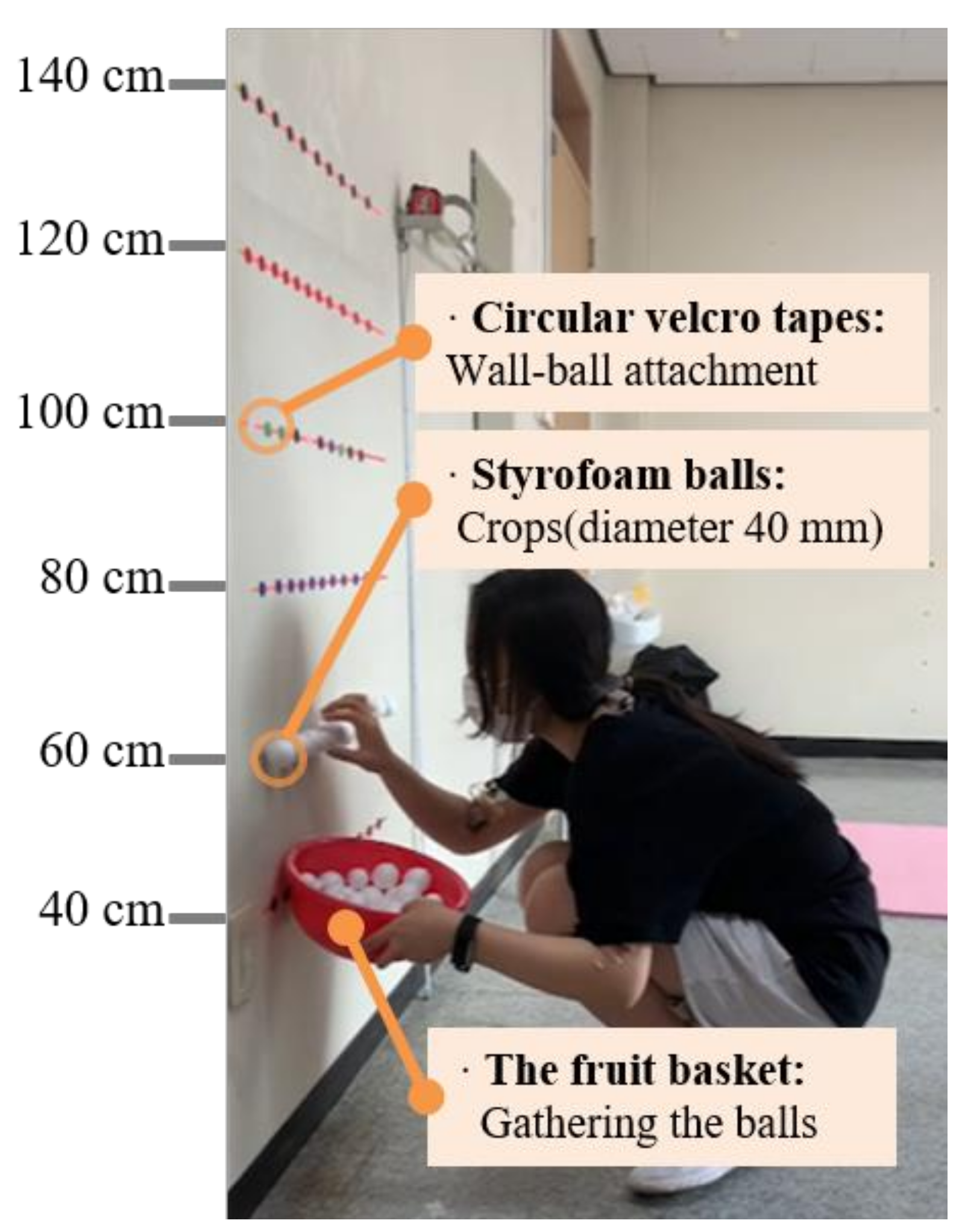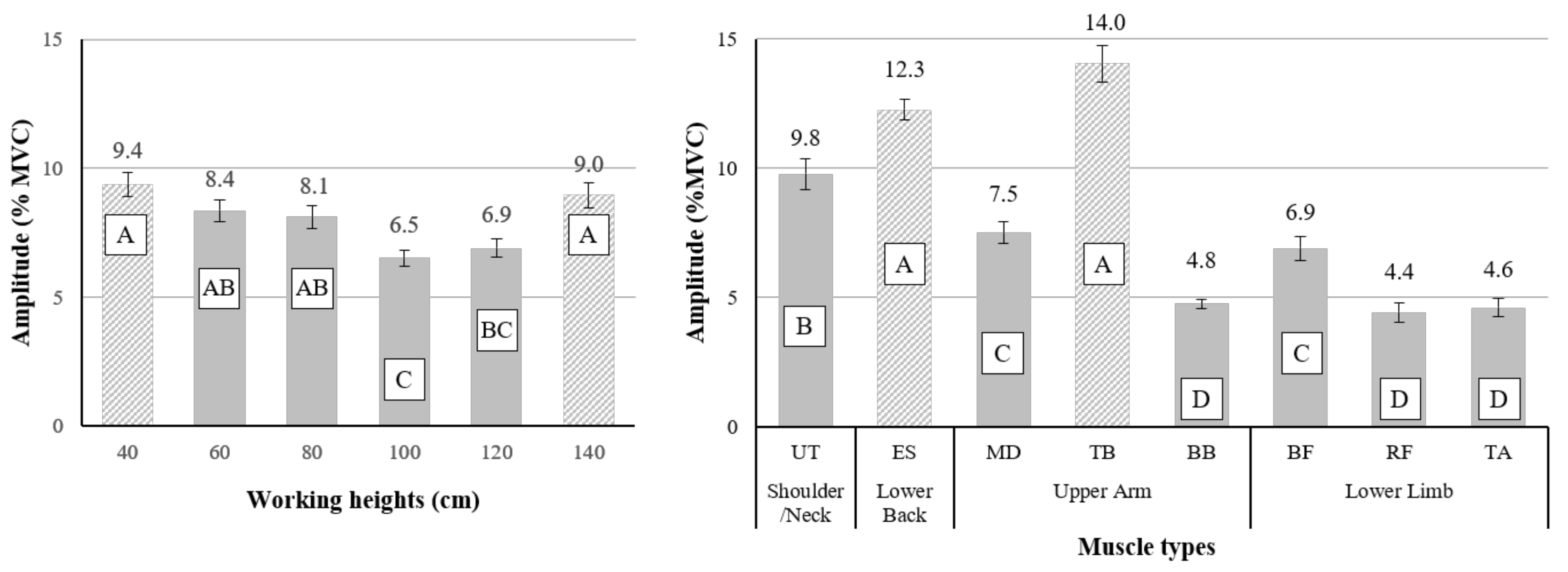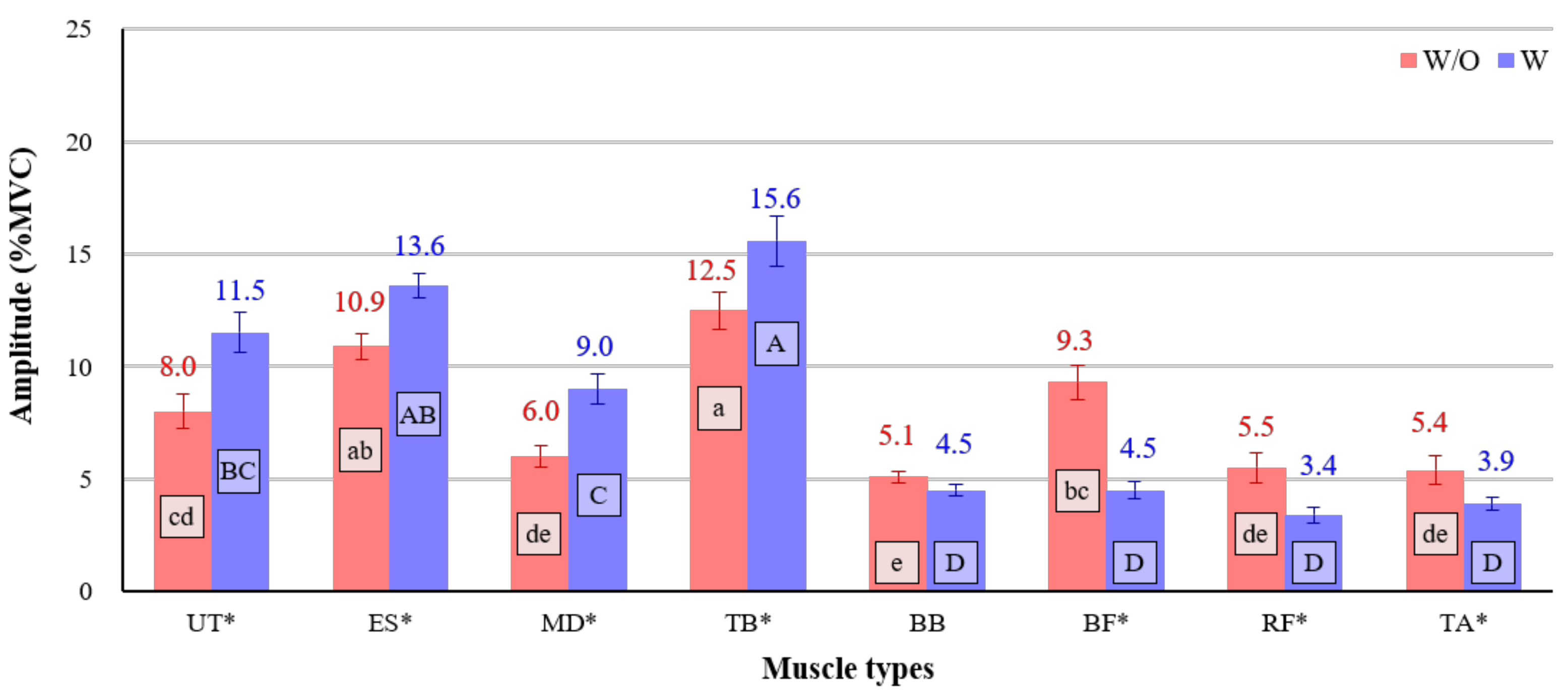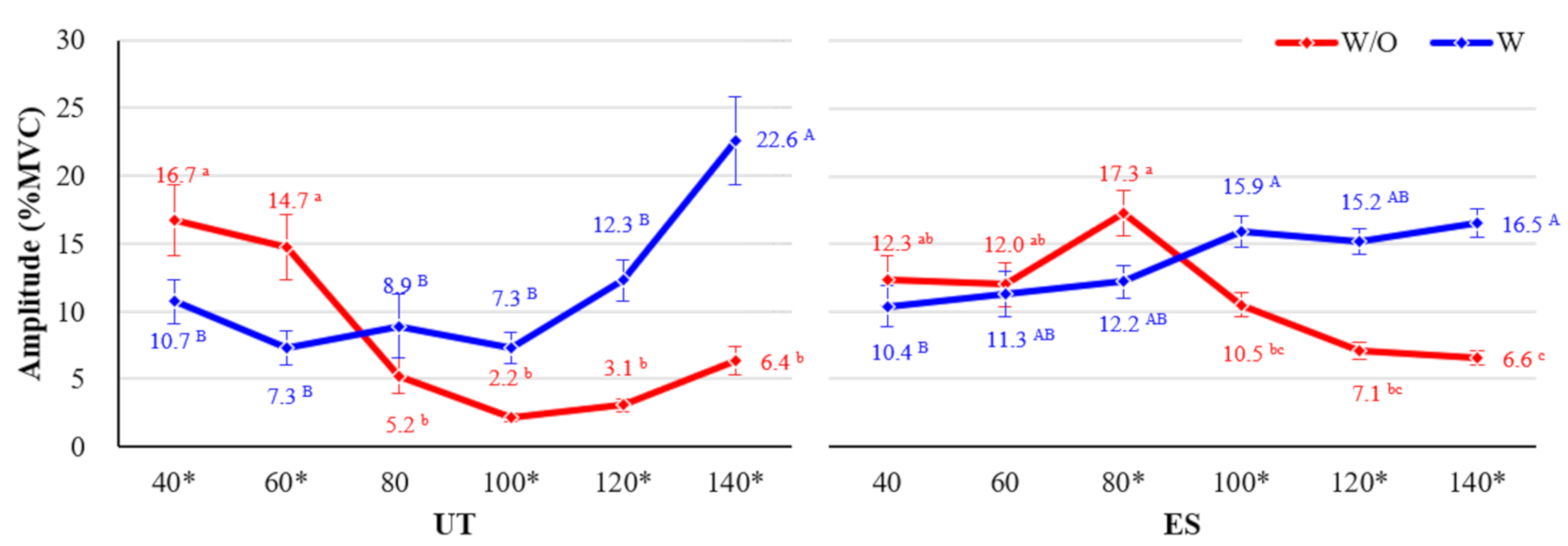Guidelines for Working Heights of the Lower-Limb Exoskeleton (CEX) Based on Ergonomic Evaluations
Abstract
1. Introduction
2. Methods
2.1. Participants
2.2. Apparatus
2.3. Experimental Procedure
2.4. Experimental Design
2.4.1. EMG Activity (% MVC)
2.4.2. Subjective Rating
3. Results
3.1. EMG Amplitude (% MVC)
3.2. Subjective Ratings
4. Discussion
5. Conclusions
Author Contributions
Funding
Institutional Review Board Statement
Informed Consent Statement
Conflicts of Interest
References
- Bureau of Labor Statistics. News Release: Nonfatal Occupational Injuries and Illnesses Requiring Days away from Work, 2015; US Department of Labor, Bureau of Labor Statistics, Safety and Health Statisticis Program: Washington, DC, USA, 2016. Available online: https://www.bls.gov/news.release/osh2.nr0.htm (accessed on 22 March 2021).
- Kivimäki, J.; Riihimäki, H.; Hänninen, K. Knee disorders in carpet and floor layers and painters. Scand. J. Work. Environ. Health 1992, 18, 310–316. [Google Scholar] [CrossRef] [PubMed]
- Leclerc, A.; Chastang, J.F.; Niedhammer, I.; Landre, M.F.; Roquelaure, Y. Incidence of shoulder pain in repetitive work. Occup. Environ. Med. 2004, 6, 39–44. [Google Scholar]
- Heydari, H.; Hoviattalab, M.; Azghani, M.R.; Ramezanzadehkoldeh, M.; Parnianpour, M. Investigation on a developed wearable assistive device (WAD) in reduction lumbar muscles activity. Biomed. Eng. Appl. Basis Commun. 2013, 25, 1–8. [Google Scholar] [CrossRef]
- Upasani, S.; Franco, R.; Niewolny, K.; Srinivasan, D. The potential for exoskeletons to improve health and safety in agriculture—Perspectives from service providers. IISE Trans. Occup. Ergon. Hum. Factors 2019, 7, 222–229. [Google Scholar] [CrossRef]
- Lee, C.G. Work-related musculoskeletal disorders in Korean farmers. J. Korean Med. Assoc. 2012, 55, 1054–1062. [Google Scholar] [CrossRef]
- Meyers, J.M.; Faucett, J.; Tejeda, D.G.; Kabashima, J.; Miles, J.A.; Janowitz, I.; Duraj, V.; Smith, R.; Weber, E. High risk tasks for musculoskeletal disorders in agricultural field work. In Proceedings of the Human Factors and Ergonomics Society Annual Meeting, Santa Monica, CA, USA, 1 July 2000; pp. 616–619. [Google Scholar]
- Kong, Y.K.; Han, J.G.; Kim, D.M. Development of an Ergonomic Checklist for the Investigation of Work-related Lower Limb Disorders in Farming—ALLA: Agricultural Lower-Limb Assessment. J. Ergon. Soc. Korea 2010, 29, 933–942. [Google Scholar] [CrossRef]
- Jung, H.S.; Jung, H.S. Evaluation of proper height for squatting stool and the ergonomic design of wearable stool. IE Interfaces 2005, 18, 288–296. [Google Scholar]
- Yun, H.S.; Hwang, Y.H.; An, C.K.; Hwang, H.J.; Rho, C.W. Working hours, working postures and fruit yield under soil nursery and soilless nursery using high bed in strawberry. Hortic. Abstr. 2003, 39. Available online: http://www.dbpia.co.kr/journal/articleDetail?nodeId=NODE06132080 (accessed on 22 March 2021).
- Jung, H.S. Analysis and improvement methods of unsafe posture associated with various agricultural works. J. Ergon. Soc. Korea 2011, 30, 473–480. [Google Scholar] [CrossRef]
- Nongsaro, Crop Technology Information—Elevated Hydroponics for Strawberry Cultivation. Available online: https://url.kr/puOY2y (accessed on 25 November 2020).
- Lee, K.S.; Kim, H.C.; Chae, H.S.; Kim, K.R.; Lim, D.S. Bio-mechanical Analysis of the Grapevine Cluster Thinning Task using Working Chair. J. Ergon. Soc. Korea 2011, 30, 395–401. [Google Scholar] [CrossRef]
- Nongsaro, Crop Technology Information—Grape Tree. Available online: https://url.kr/QlBPFW (accessed on 25 November 2020).
- DeLooze, M.P.; Bosch, T.; Krause, F.; Stadler, K.S.; O’Sullivan, L.W. Exoskeletons for industrial application and their potential effects on physical work load. Ergonomics 2015, 59, 671–681. [Google Scholar] [CrossRef]
- Steinhilber, B.; Seibt, R.; Rieger, M.A.; Luger, T. Postural control when using an industrial lower limb exoskeleton: Impact of reaching for a working tool and external perturbation. Hum. Factors 2020, 1–13. [Google Scholar] [CrossRef]
- Lee, D.W.; Jung, J.Y.; Kim, B.S.; Son, Y.K.; Shin, H.C. Trends in Wearable Assistive Robotics Technology. Electron. Telecommun. Trends 2017, 32, 21–30. [Google Scholar]
- Barrett, A.L.; Fathallah, F.A. Evaluation of four weight transfer devices for reducing loads on the lower back during agricultural stoop labor. In Proceedings of the American Society of Agricultural Engineers, Sacramento, CA, USA, 29 July–1 August 2001. [Google Scholar]
- Ulrey, B.L.; Fathallah, F.A. Effect of a personal weight transfer device on muscle activities and joint flexions in the stooped posture. J. Electromyogr. Kinesiol. 2013, 23, 195–205. [Google Scholar] [CrossRef] [PubMed]
- Rashedi, E.; Kim, S.; Nussbaum, M.A.; Agnew, M.J. Ergonomic evaluation of a wearable assistive device for overhead work. Ergonomics 2014, 57, 1684–1874. [Google Scholar] [CrossRef] [PubMed]
- Bosch, T.; van Eck, J.; Knitel, K.; de Looze, M. The effects of a passive exoskeleton on muscle activity, discomfort and endurance time in forward bending work. Appl. Ergon. 2016, 54, 212–217. [Google Scholar] [CrossRef]
- Van Engelhoven, L.; Poon, N.; Kazerooni, H.; Barr, A.; Rempel, D.; Harris-Adamson, C. Evaluation of an Adjustable Support Shoulder Exoskeleton on Static and Dynamic Overhead Tasks. In Proceedings of the Human Factors and Ergonomics Society 2018 Annual Meeting, Philadelphia, PA, USA, 1–5 October 2018; Sage CA: Los Angeles, CA, USA, 2019; pp. 804–808. [Google Scholar]
- Huysamen, K.; de Looze, M.; Bosch, T.; Ortiz, J.; Toxiri, S.; O’Sullivan, L.W. Assessment of an active industrial exoskeleton to aid dynamic lifting and lowering manual handling tasks. Appl. Ergon. 2018, 68, 125–131. [Google Scholar] [CrossRef]
- Kim, S.; Nussbaum, M.A.; Esfahani, M.I.M.; Alemi, M.M.; Alabdulkarim, S.; Rashedi, E. Assessing the influence of a passive, upper extremity exoskeletal vest for tasks requiring arm elevation: Part I “Expected” effects on discomfort, shoulder muscle activity, and work task performance. Appl. Ergon. 2018, 70, 315–322. [Google Scholar] [CrossRef] [PubMed]
- Luger, T.; Seibt, R.; Cobb, T.J.; Rieger, M.A.; Steinhilber, B. Influence of a passive lower-limb exoskeleton during simulated industrial work tasks on physical load, upper body posture, postural control and discomfort. Appl. Ergon. 2019, 80, 152–160. [Google Scholar] [CrossRef]
- Iranzo, S.; Piedrabuena, A.; Iordanov, D.; Martinez-Iranzo, U.; Belda-Lois, J.M. Ergonomics assessment of passive upper-limb exoskeletons in an automotive assembly plant. Appl. Ergon. 2020, 87, 103–120. [Google Scholar] [CrossRef]
- Pillai, M.V.; Van Engelhoven, L.; Kazerooni, H. Evaluation of a lower leg support exoskeleton on floor and below hip height panel work. Hum. Factors 2020, 62, 489–500. [Google Scholar] [CrossRef] [PubMed]
- Moyon, A.; Poirson, E.; Petiot, J.F. Experimental study of the physical impact of a passive exoskeleton on manual sanding operations. Procedia CIRP 2018, 70, 284–289. [Google Scholar] [CrossRef]
- Baltrusch, S.J.; Van Dieën, J.H.; Van Bennekom, C.A.M.; Houdijk, H. The effect of a passive trunk exoskeleton on functional performance in healthy individuals. Appl. Ergon. 2018, 72, 94–106. [Google Scholar] [CrossRef]
- Alabdulkarim, S.; Nussbaum, M.A. Influences of different exoskeleton designs and tool mass on physical demands and performance in a simulated overhead drilling task. Appl. Ergon. 2019, 74, 55–66. [Google Scholar] [CrossRef] [PubMed]
- Gillette, J.C.; Stephenson, M.L. EMG analysis of an upper body exoskeleton during automotive assembly. In Proceedings of the 42nd Annual Meeting of the American Society of Biomechanics, Rochester, NY, USA, 8–11 August 2018; pp. 308–309. [Google Scholar]
- Otten, B.M.; Weidner, R.; Argubi-Wollesen, A. Evaluation of a novel active exoskeleton for tasks at or above head level. IEEE Robot. Autom. Lett. 2018, 3, 2408–2415. [Google Scholar] [CrossRef]
- Spada, S.; Ghibaudo, L.; Carnazzo, C.; Di Pardo, M.; Chander, D.S.; Gastaldi, L.; Cavatorta, M.P. Physical and Virtual Assessment of a Passive Exoskeleton. In Proceedings of the 20th Congress of the International Ergonomics Association (IEA 2018). Volume VIII: Ergonomics and Human Factors in Manufacturing, Agriculture, Building and Construction, Sustainable Development and Mining, Florence, Italy, 26–30 August 2018; Spinger: Cham, Switzerland; pp. 247–257. [Google Scholar]
- Zipp, P. Recommendations for the standardization of lead positions in surface electromyography. Eur. J. Appl. Physiol. 1982, 50, 41–54. [Google Scholar] [CrossRef]
- Mirka, G.A. The quantification of EMG normalization error. Ergonomics 1991, 34, 343–352. [Google Scholar] [CrossRef] [PubMed]
- Basmajian, J.V.; deLuca, C.J. Muscle Alive: Their function revealed by electromyography, 5th ed.; Williams & Wilkins: Baltimore, MD, USA, 1985; pp. 65–97. ISBN 978-06-8300-414-4. [Google Scholar]
- Borg, G. Borg’s Perceived Exertion and Pain Scales; Human Kinetics: Champaign, IL, USA, 1998; pp. 1–97. [Google Scholar]
- Theurel, J.; Desbrosses, K.; Roux, T.; Savescu, A. Physiological consequences of using an upper limb exoskeleton during manual handling tasks. Appl. Ergon. 2018, 67, 211–217. [Google Scholar] [CrossRef] [PubMed]










| Gender | Age (Year) | Height (cm) | Weight (kg) |
|---|---|---|---|
| Male | 22.5 ± 2.0 | 176.4 ± 4.2 | 72.0 ± 11.6 |
| Female | 20.7 ± 1.2 | 165.5 ± 4.4 | 57.2 ± 3.8 |
Publisher’s Note: MDPI stays neutral with regard to jurisdictional claims in published maps and institutional affiliations. |
© 2021 by the authors. Licensee MDPI, Basel, Switzerland. This article is an open access article distributed under the terms and conditions of the Creative Commons Attribution (CC BY) license (https://creativecommons.org/licenses/by/4.0/).
Share and Cite
Kong, Y.-K.; Park, C.-W.; Cho, M.-U.; Kim, S.-Y.; Kim, M.-J.; Hyun, D.J.; Bae, K.; Choi, J.K.; Ko, S.M.; Choi, K.-H. Guidelines for Working Heights of the Lower-Limb Exoskeleton (CEX) Based on Ergonomic Evaluations. Int. J. Environ. Res. Public Health 2021, 18, 5199. https://doi.org/10.3390/ijerph18105199
Kong Y-K, Park C-W, Cho M-U, Kim S-Y, Kim M-J, Hyun DJ, Bae K, Choi JK, Ko SM, Choi K-H. Guidelines for Working Heights of the Lower-Limb Exoskeleton (CEX) Based on Ergonomic Evaluations. International Journal of Environmental Research and Public Health. 2021; 18(10):5199. https://doi.org/10.3390/ijerph18105199
Chicago/Turabian StyleKong, Yong-Ku, Chae-Won Park, Min-Uk Cho, Seoung-Yeon Kim, Min-Jung Kim, Dong Jin Hyun, Kihyeon Bae, Jong Kyu Choi, Sang Min Ko, and Kyeong-Hee Choi. 2021. "Guidelines for Working Heights of the Lower-Limb Exoskeleton (CEX) Based on Ergonomic Evaluations" International Journal of Environmental Research and Public Health 18, no. 10: 5199. https://doi.org/10.3390/ijerph18105199
APA StyleKong, Y.-K., Park, C.-W., Cho, M.-U., Kim, S.-Y., Kim, M.-J., Hyun, D. J., Bae, K., Choi, J. K., Ko, S. M., & Choi, K.-H. (2021). Guidelines for Working Heights of the Lower-Limb Exoskeleton (CEX) Based on Ergonomic Evaluations. International Journal of Environmental Research and Public Health, 18(10), 5199. https://doi.org/10.3390/ijerph18105199





